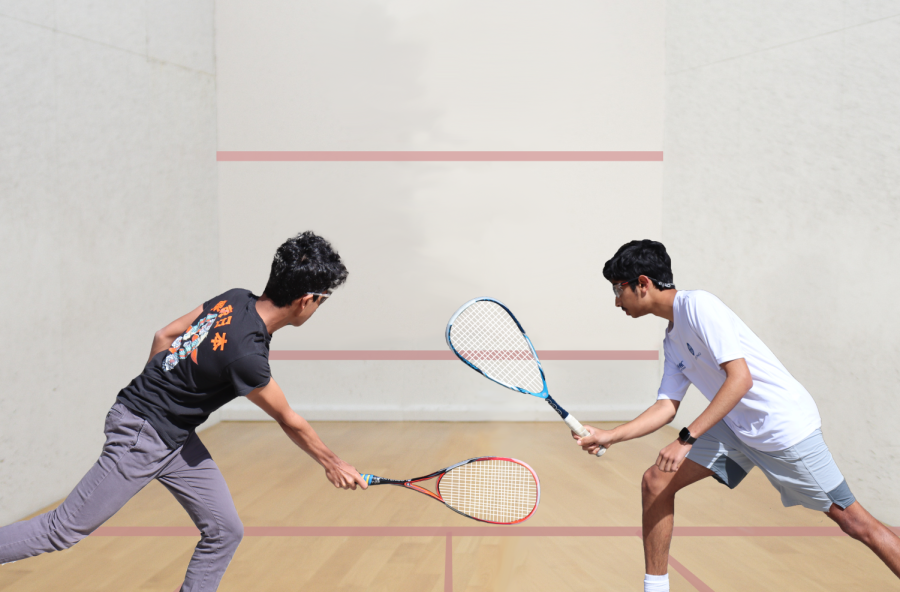Student athletes squash their way to victory
Photos by Anushka Anand Graphic illustration by Calvin Zhou
Squash is a racket sport played by two players in an indoor four-walled court with a small, hollow rubber ball.
March 10, 2023
Junior Nikhil Kanchi heats up the two-dotted rubber squash ball, rolling it under his foot, ready to serve to junior Abhinav Athreya. As Athreya shoves his feet back and forth in anticipation of the upcoming serve, Kanchi draws his arm back, his racket contacting the ball in a match that signifies the winner of the Under 17 (U17) men’s division at the Bay Club San Francisco’s gold tournament in 2022.
Squash is a racket sport played by two players in an indoor four-walled court with a small, hollow rubber ball. After the ball is served, the players take turns hitting the ball against the front wall under red lines, which mark the court’s boundaries.
Following his older sister, Kanchi started playing squash in the summer of 2014. He faced the tough decision of choosing between squash and tennis, but ultimately fell in love with the indoor court of squash and the competitiveness and excitement that came with each match. Kanchi also loved meeting others in his age group who had similar interests.
“It was just a fun way to spend time with others outside of school,” Kanchi said.
Before playing squash, Athreya played basketball and soccer. He began playing squash in February 2016 after being inspired by his friends who played squash — Kanchi being one of them. They encouraged him to play and told him the great parts about the sport. Athreya’s skill set suited this sport since it relies heavily on strategy.
“I wasn’t very good with the ball and racket when I first started playing,” Athreya said. “But as soon as I lifted my racket for the first time, I never wanted to put it down. Even after trying many different sports, I enjoyed squash the most.”
Kanchi finds the crosscourt nick, a length shot that goes from one side of the court to the back corner of the other, to be one of his favorite shots because it is really hard for the opponent to continue playing after. Athreya values the straight drive, a shot in which the ball is hit to run parallel along the side wall and land in the back corner.
After winning their first U11 tournaments, Kanchi and Athreya tried to play as many tournaments, usually a month or two apart, to improve their ratings and rankings. As squash is played more on the East Coast, especially in New York and Philadelphia, the sport requires a lot of traveling. Kanchi has played tournaments in 27 states, while Athreya enjoys playing in the tournaments closer to home since he may not have as much time to travel for the tournaments hosted on the East Coast.
Being both academically and athletically rigorous student-athletes, Kanchi and Athreya have worked to find their balance between school and squash and remind themselves every day of their priorities.
“I just have to push myself to set aside time for squash,” Athreya said. “I add it as a big priority and major part of my schedule, not just something I can choose to skip.”
After school, Kanchi makes a stop at home and heads to the courts until around 6:30 p.m. After taking a shower and eating dinner, he starts his homework at 8:30 p.m. Whenever he finds time between coming home and playing squash, Kanchi tries to get as much of his homework done.
Both athletes believe that being mentally tough and staying calm on the court is critical to doing well during matches — especially higher-level matches in which rallies become longer and harder.
Athreya’s way of calming himself down is by taking each game one point at a time.
“Even if I’m losing, I just think about how I can win that current point,” Athreya said. “I try not to focus on what happened before or what is going to happen after.”
In preparation for each match, Kanchi tries to maintain both his mentality and physical fitness by finding a place to relax after warming up. He tightens his shoes and has a light sweat to make sure his body is warmed up and ready to play. During the match, he gives himself tips on how he should be playing, repeating to himself how he needs to overcome the biggest mistake he made on the court that day. Whether he wins or loses a point, or even a game, Kanchi makes sure he doesn’t react or show his positive or negative emotions to his opponent to keep his mind focused.
Dry patches, especially after the COVID-19 pandemic, required the players to work extra hard to catch up to other athletes in their divisions.
“Because of the pandemic, I hadn’t played for a year and a half,” Kanchi said. “It took me a while to catch up to other players who had improved a lot, especially since I was aging up to the next division.”
However, the supportive and competitive nature of tournaments has always been a major source of motivation for Kanchi and Athreya to continue playing.
After every tournament, Kanchi plans a dinner with his friends to celebrate matches he played during the day. Both athletes love traveling around the country to participate in tournaments. Athreya especially loved Greenwich, Conn. for its architecture and weather, while Kanchi enjoyed Philadelphia, Pa. for its big student life and good restaurants.
Each practicing two-hour sessions five to six times per week, Athreya is ranked 137 nationally in the U17 men’s division and Kanchi is ranked 55 in U19.
“Playing by yourself might not be as fun as playing against someone else,” Athreya said. “But training on your own against the wall is crucial to improving.”
Kanchi and Athreya are grateful for the stress relief squash provides and the friends they have made while playing. Squash remains a vital part of both athletes’ lives. They are currently in the college recruitment process and are excited to keep playing in the future.
“A lot of people overlook squash because it’s not that popular on the West Coast,” Athreya said. “And I think people would be much more interested if they learned more about it.”




























































